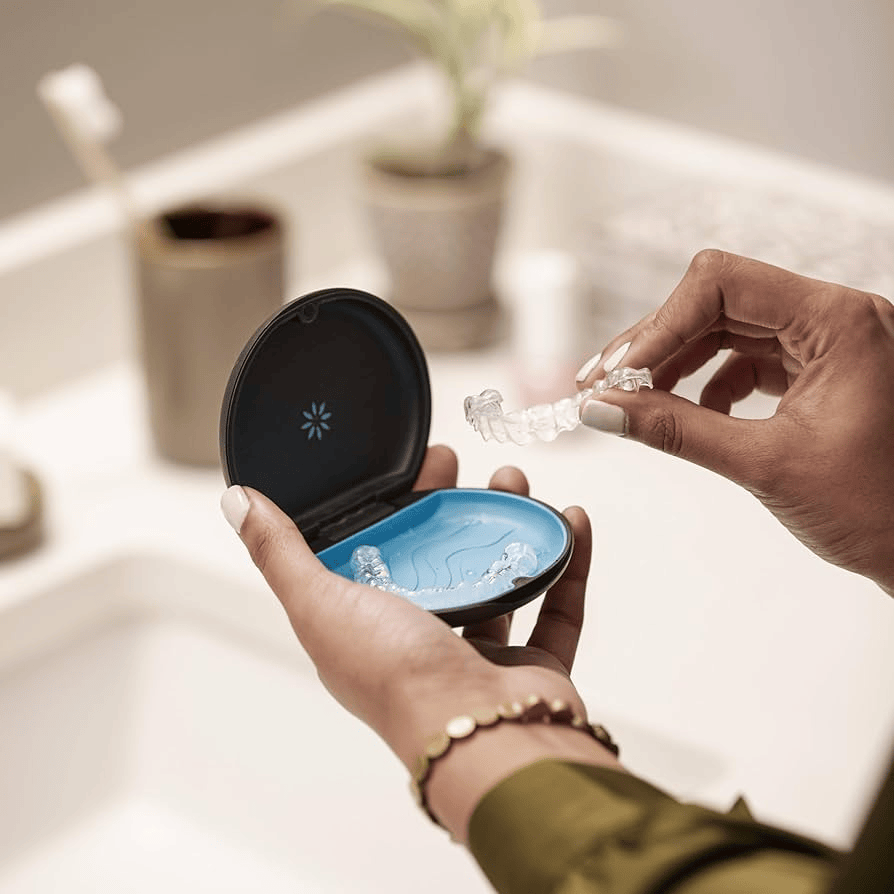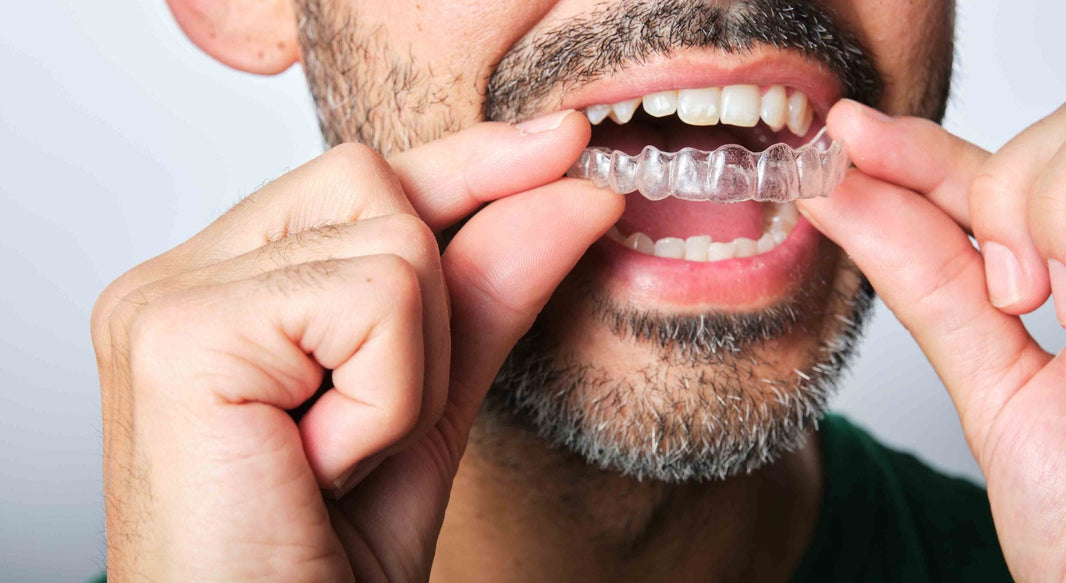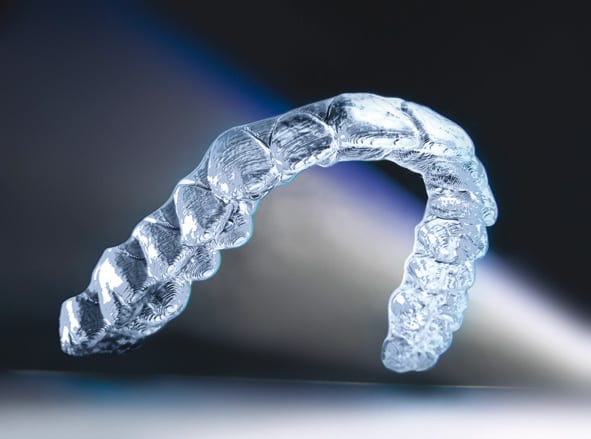If your Invisalign elastic button or hook breaks, don’t panic—it’s not a dental emergency, but it does need attention. In most cases, you can continue wearing your aligners while avoiding rubber bands until your orthodontist provides guidance. Use this home care guide to understand what happened, how to stay on track, and when to schedule a quick repair.
Table of contents
Why Elastic Buttons Are Used with Invisalign Aligners
Not all Invisalign cases require elastic buttons—but for more complex movements like jaw alignment or bite correction, they’re essential. Buttons are either bonded directly onto your tooth surface (as small composite mounds) or integrated into the aligner as precision cuts that hold rubber bands. These bands help guide your upper and lower arches into the correct bite position.
Buttons serve as anchorage points, turning your aligners into multi-directional tools—not just trays that move teeth inward or outward. The success of these movements depends on consistent wear of rubber bands and intact button placement. When a button breaks off, your aligner may no longer function as designed, and bite correction can stall.
Used for jaw alignment, crossbite, overbite, and underbite correction
Serve as anchor points for elastics, applying inter-arch pressure
Can be bonded to teeth or embedded in the aligner as hooks
Critical to advanced Invisalign treatment stages
Causes of Invisalign Elastic Buttons or Attachments to Break Off
Elastic buttons can break off for several reasons—especially during eating, removal, or tray reinsertion. Biting down too forcefully, twisting the aligners while removing them, or applying too much tension with rubber bands can all weaken the composite material that holds the button in place. Patients who clench or grind their teeth (bruxism) may also experience more breakage.
Wear and tear is normal, but certain habits increase the likelihood of breakage significantly. Knowing the causes can help prevent future issues while you wait for professional repair.
Forceful removal or reinsertion of aligners
Biting down on hard or sticky foods with aligners in
Overstretching rubber bands or incorrect elastic placement
Tooth grinding (bruxism) during sleep
Long-term wear weakening composite bonding

When to Call Your Orthodontist About a Broken Aligner
While a missing button doesn’t always warrant a same-day emergency visit, it’s not something to ignore. If your aligner no longer holds elastics in place, your bite correction phase may pause. Promptly calling your orthodontist ensures they can adjust your plan, replace the button, or provide guidance on what to do until your next visit.
Delaying repair can affect how your jaw and teeth respond to treatment, particularly if you're in an active elastics phase.
Rubber bands no longer stay in place or hook securely
The button fell off completely or was swallowed
You can’t find a substitute hook or workaround
Your aligner no longer fits snugly or feels misaligned
You’re unsure whether to continue wearing elastics
What to Do at Home If Your Elastic Hook or Button Breaks
Until you’re able to get the button professionally replaced, there are a few steps you can take to minimize disruption to your Invisalign treatment. Your orthodontist may recommend temporarily pausing elastics or using a backup hook on the opposite arch, depending on your case. In the meantime, keeping the area clean and avoiding added stress on the damaged site will help avoid further complications.
Inspect the aligner and the affected tooth to confirm the issue
Do not continue wearing elastics unless your orthodontist approves
Store your elastics in a clean case until instructed to resume use
Use a salt water rinse to reduce irritation or inflammation
Continue wearing your aligners as usual unless told otherwise
Preventing Button Breakage on Clear Aligners
Once your elastic button is repaired, adjusting your daily habits can prevent it from happening again. Avoid removing your aligners by pulling from the front, as this creates torque around the button area. Use both hands to loosen from the back molars and gently peel forward. Also, be cautious when stretching rubber bands—make sure they're positioned evenly and not twisted.
Proper oral hygiene also helps, since debris buildup around attachments can weaken their bond.

Always remove aligners using both hands—start from the molars
Do not bite down with trays in, especially while chewing hard foods
Apply rubber bands gently and evenly—avoid over-stretching
Brush carefully around attachment areas to prevent plaque buildup
Use a removal tool if you struggle to grip aligners with short nails
Time to Book? Get Button Repairs Quickly
Although a broken button isn’t a dental emergency, it can become a treatment delay if left unaddressed. Some orthodontists can rebond buttons quickly with little to no extra cost, especially if it's part of your current aligner phase. Others may recommend continuing treatment until your next scheduled visit—but only with clear instructions.
Booking a repair visit within 3–5 days is ideal to keep tooth and jaw movement progressing as planned.
Contact your orthodontist within 24–48 hours of button failure
Ask if remote photo triage is possible for a faster solution
Schedule an in-person visit within 3–5 days if needed
Bring your current aligners and elastics to the appointment
Follow updated instructions carefully if your tray is adjusted
What happens if my Invisalign button breaks?
If your elastic button breaks, your aligner may no longer hold rubber bands effectively. This can delay bite correction, so it’s important to contact your orthodontist for a replacement or alternative strategy.
Can I still wear my aligners if the elastic hook breaks?
Yes, you should continue wearing your aligners unless instructed otherwise. However, you should stop using rubber bands until your orthodontist evaluates the situation.
Is a broken button a treatment emergency?
It’s not a dental emergency, but it does require attention. Bite correction relies on elastic pressure, so any interruption in force application should be addressed within a few days.
What should I do if I dropped and stepped on my aligner?
If you dropped and stepped on your Invisalign aligner, stop wearing it immediately and store it in its case. Contact your orthodontist for next steps—they may recommend switching to your previous tray, ordering a replacement, or advancing to the next stage if appropriate.
Can I fix a broken button on an aligner myself?
No. Elastic buttons are bonded to your teeth or precision-cut into the aligner and require professional tools and materials for replacement. Do not attempt to glue or repair them at home.
How long does it take to replace a button?
Most button replacements take 15–30 minutes during a standard orthodontic visit. Some providers may even offer same-day repairs.
Why do my Invisalign buttons keep breaking?
Frequent breakage may be caused by improper aligner removal, bruxism, or poor rubber band placement. Your orthodontist can evaluate and adjust techniques or materials as needed.






